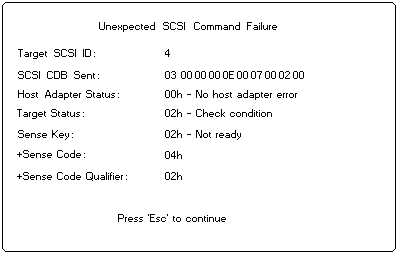Using the SCSISelect Utility (Netfinity 7000-M10 - Type 8680)
Using the SCSISelect Utility
Note: If the server has a RAID adapter installed, use the configuration
method supplied with the RAID adapter to view or change SCSI settings for attached devices.
The server comes with a menu-driven configuration utility, called SCSISelect,
that allows you to view and change SCSI settings.
You can use the SCSISelect Utility to:
- View and change the default SCSI IDs
- Verify and change configuration conflicts
- Perform a low-level format on a SCSI hard disk
- Verify disk media
Starting the SCSISelect Utility: You can access this program when
you start the server.
The SCSISelect prompt appears after the IBM logo appears.
Press Ctrl+A immediately after the SCSISelect prompt appears:
<<< Press <CTRL><A> for SCSISelectÓ Utility! >>>
Use the Up Arrow (  ) or Down Arrow (
) or Down Arrow (  ) key to move the highlight bar to the
various menu choices.
) key to move the highlight bar to the
various menu choices.
Press Esc to return to the previous menu. Also, you can press the F5 key to switch
between color and monochrome modes (if the monitor permits).
To change the settings of the displayed items, follow the directions on the screen. Then, press Enter.
SCSISelect Utility Choices: The following choices appear on the SCSISelect Utility menu:
- Configure/View Host Adapter Settings
- SCSI Disk Utilities
Configure/View Host Adapter Settings: To view or change the SCSI controller
settings, select Configure/View Host Adapter Settings and follow the directions on the screen.
Note: On the SCSISelect Utility menu, the SCSI controller is referred to as
the Host Adapter.
This menu has the following choices:
- Host Adapter SCSI ID
The default SCSI ID of the SCSI controller is 7. Do not change this value.
- SCSI Parity Checking
The default value is Enabled. Do not change this value.
- Host Adapter SCSI Termination
The default value is Automatic. Do not change this value.
- Boot Device Configuration
Select this choice to configure startable device parameters. Before you can make updates, you must
know the ID of the device whose parameters you want to configure.
- SCSI Device Configuration
Select this choice to configure SCSI device parameters. Before you can make updates, you must
know the ID of the device whose parameters you want to configure.
Note: When the Maximum Sync Transfer Rate is set to 40.0, this value represents the transfer rate for
UltraSCSI devices.
When the Maximum Sync Transfer Rate is set to 20.0, this value represents the transfer rate for Fast SCSI
devices.
- Advanced Configuration Options
Select this choice to view or change the settings for advanced configuration options.
These options include enabling support for large hard disk drives and support for drives with UltraSCSI speed.
To reset the SCSI controller defaults, press F6, then, follow the directions on the screen.
SCSI Disk Utilities: To see the IDs that are assigned to each SCSI device or
to format a SCSI device, select SCSI Disk Utilities from the SCSISelect Utility menu.
To use the utility, select a drive from the list. Read the screens carefully before making a selection.
Note: If the following screen appears, you might have pressed Ctrl+A before
the selected drives were ready.
Restart the server and watch the SCSISelect messages as each drive spins up. After the drive that
you want to view or format spins up, press Ctrl+A.

Performing a Low-Level Disk Format: You can use the Format Disk feature of the
SCSISelect Utility to perform a low-level format on a hard disk drive.
Depending on the hard disk drive capacity, the low-level format program could take up to two hours.
When To Use the Low-Level Format Program: Use the Low-Level Format program:
- When you are installing software that requires a low-level format
- When you get recurring messages from the diagnostic tests directing you to run the Low-Level Format
program on the hard disk drive
- As a last resort before replacing a failing hard disk drive
Note: For information about backing up all of the files, see the
operating-system documentation.
Starting the Low-Level Format Program
 - Attention - The low-level format program erases
all data and programs.
- Attention - The low-level format program erases
all data and programs.
Note: If the server has a RAID adapter installed, refer to the RAID adapter
documentation for instructions for performing a low-level format on a hard disk drive attached to the PCI RAID adapter.
- If the hard disk is working, make a backup copy of all the files and programs on the hard disk drive
- Select Format Disk, then, follow the instructions on the screen.
Note: Hard disks normally contain more tracks than their stated capacity
(to allow for defective tracks).
A message appears on the screen if the defect limit is reached. If this happens, replace the drive.
- To install an operating system after the hard disk drive is formatted, follow the instructions in the
'Software and Netfinity Manager Reference' section of this Server Library.
Verify Disk Media: The verify disk media utility scans the drive for defective sectors. All recoverable
information found on defective sectors is remapped to alternate sectors.
This utility also indicates if the drive is defective.
Use this utility if you suspect bad sectors on a disk drive.
Back to 
Please see the LEGAL - Trademark notice.
Feel free - send a  for any BUG on this page found - Thank you.
for any BUG on this page found - Thank you.
 ) or Down Arrow (
) or Down Arrow (  ) key to move the highlight bar to the
various menu choices.
) key to move the highlight bar to the
various menu choices.

 - Attention - The low-level format program erases
all data and programs.
- Attention - The low-level format program erases
all data and programs.
